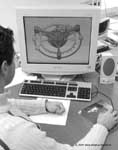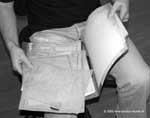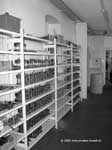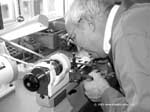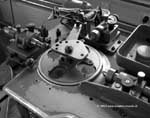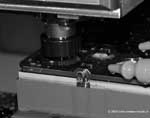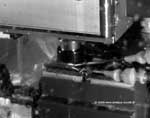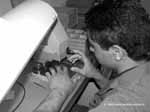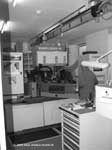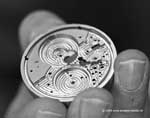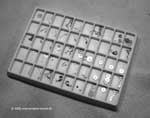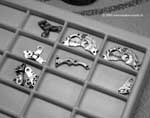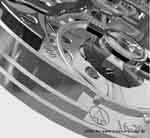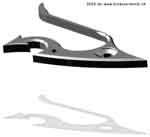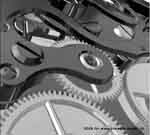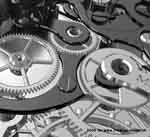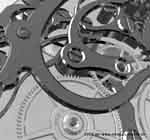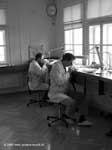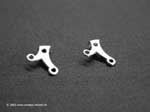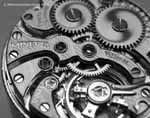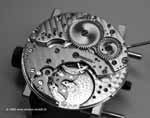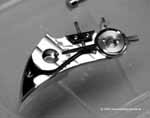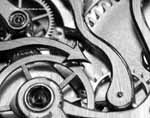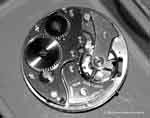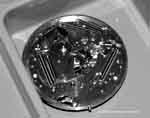Like Phoenix from the ashes - the astonishing rebirth of Minerva SA, Villeret
by Magnus Bosse, May 2005
Part
2
click on small images to view full-size ones!
2.
Watchmaking at Minerva today
2.1 The production of parts: old meets new world!
Well, to start it is right from the beginning: The equipe around Demetrio
Cabiddu (see image with his young technical/construction team) did a
good job in changing and improving nearly everything that they found
in Villeret. After raising an inventory it was pretty clear to them
that the task was not only an evolution, but instead a true revolution
was necessary: Almost no plans of the calibres in production were available,
and the toolings at hand were in a more or less unsatisfying condition.
The precision they were aiming for was impossible to achieve with the
machines that did their job until then. So, they had to measure each
and every movement part with the aim to industrialise them again using
modern CAD technologies (small images below: left image, CAD construction;
right image, one of the few old drawings).
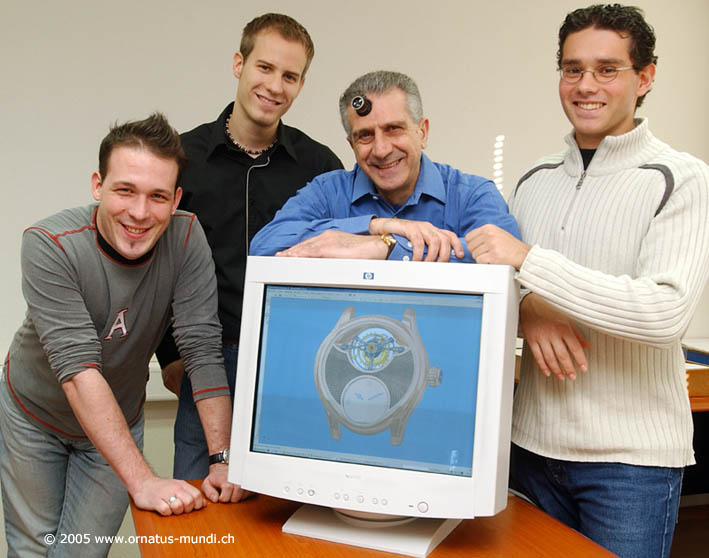
Although
Minerva preserved all the tools that were available (large image; small
image, left) for a good reason (they are still used to produce spare
parts for some older Minerva movements), they cannot be used for the
production of parts for current movements. Despite the similar layout
of most of the current Minerva movements to the older ones, the parts
are not interchangable. The reason is that the precision in
production of the current Minerva movements is much higher, so that
the positioning and design of many wheels and gears could be improved
in order to enhance precision and meet new, strict tolerances.
For
the actual production of the parts, however, 'old' and 'new' Minerva
eras still go hand in hand: The blanket plates used as 'raw material'
are cut out of raw metal plates using the old Minerva stamps (large
image). Even Mr. Loichot, a toolmaker who is with Minerva now for more
than 50 years, still works there, and this with a most infectious fun
with his work (small image, middle)! He is also responsible for the
vertical drilling machine still used today (small image, right).
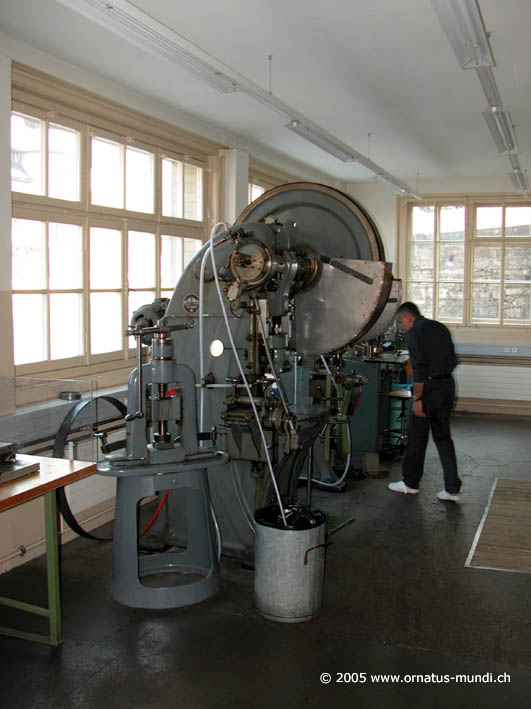
There are two different CNC machines used for a good reason: The movement plates are nowadays made of Maillechort, also known as German Silver, while levers etc. are cut from steel, a relatively difficult to machine material. Both materials are processed using specialised CNC machines. For steel parts, the production is a two-step process: Pre-cutting with CNC first, followed by spark erosion in a second step (small image right).
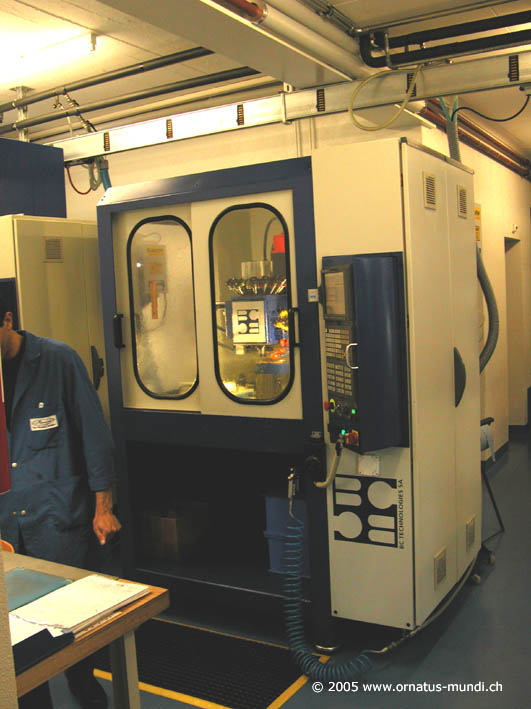

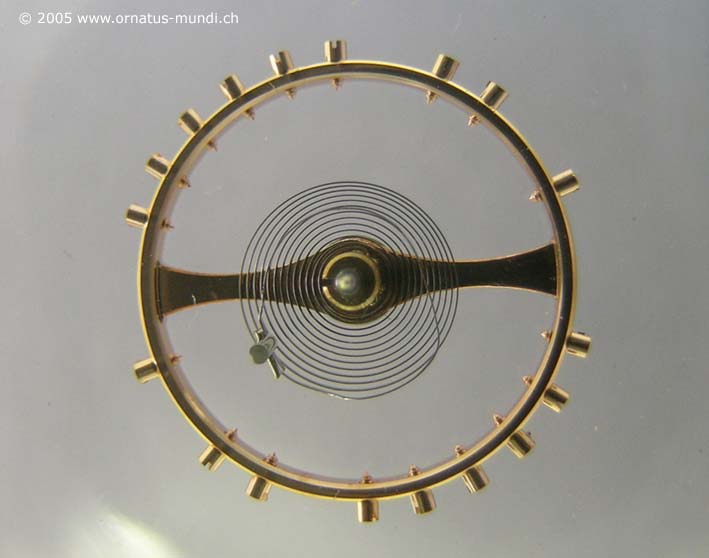
2.2.1 The new Minerva Double Regulator
Imagine you are a contemporary movement designer and your task is to design a regulation unit for a mechanical, high-grade movement. For today's watchmakers the diverse requests and desires associated with this task are often difficult to incorporate into one movement: The puristic watchmaker deep in your heart wants to deliver the ultimate movement in a technical sense, and therefore would probably opt for a freesprung balance (because this layout ensures perfect centering of the hairspring and an adjustment without affecting it). The service department most likely requests an easy to adjust, trouble-free solution, for example the Etachron system. And the customer, mesmerised by the antique charm of watchmaking, would like to see a Swan's Neck microregulator acting of the balance via curb pins on the regulator. So what to do?
As you are working for a Haute Horlogerie manufacture, you certainly want to find a solution that above all is aesthetically pleasant as well. So did the watchmakers at Minerva, and they took the long road and came up with a construction that manages to combine all the wishes voiced above: Minerva's unique Double Regulator!
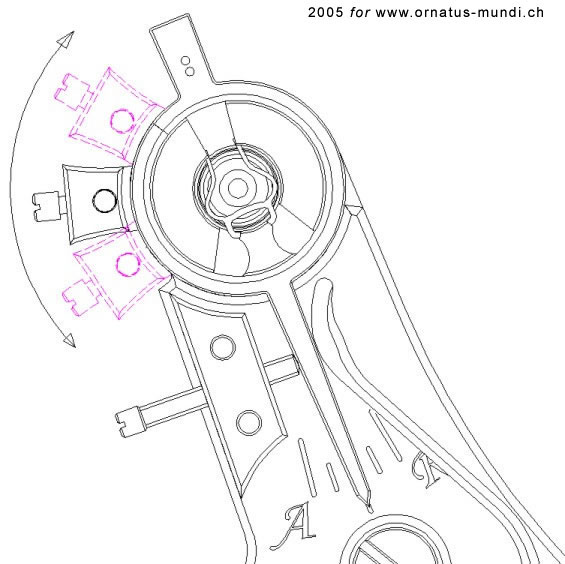
As you can see, there is the 'standard' Swan's Neck spring on the regulator, which adjusts the active length of the hairspring. The problem with such a set-up is that almost never the hairspring is perfectly centered with the balance axis, thus creating additional problems for timekeeping (especially variations between the different positions of a watch). A freesprung balance avoids this peril point, because here the active length of the hairspring is kept constant (= optimally concentric to the balance axis). The rate regulation takes place via altering the inertia of the balance itself by means of adjusting weights (screws or eccentric plates like Patek Philippe's Gyromax). Minerva's watchmakers now thought how they could keep the Swan's Neck, but added an adjustment device allowing for centering the haispring. The solution is second regulator, which moves the entire balance fixation to the balance cock, the stud (large image; small image, left). With the adjustment of the relative position between the movable stud and the curb pins (via Swan's Neck microregulator) both, the active length of the hairspring and its perfect centering to the central axis are accomplished. To draw the attention of the Minerva aficionado to this new device, the Swan's Neck itself was redesigned and now carries proudly the Minerva arrow (on some movements; small image, right).
Column wheel Chronographs are highly praised by watch collectors: its beauty, the difficulty to manufacture the column wheel mechanism, the smoothness of its operation and the preciseness of the control such a mechanism exhibits over the Chronograph are characteristic and well appreciated factors.
Minerva went one step ahead and sought to improve the precision of the time measurement by optimising the interaction of the transfer wheel (which is mounted in the axis of the seconds wheel and engages, once the Chronograph is switched on, with the intermediate wheel to transfer the energy to the Chronograph seconds counter) with the intermediate wheel. This is achieved by altering the shape of the teeth on the transfer wheel to a more rounded, nearly epicycloidal shape of the teeth. This allows for a maximun of depth of engagement between the two wheels while minimising friction, resulting in an increased regularityand consistency of interaction (large image; small image, left). According to Demetrio Cabiddu, the amplitude of the balance stays constant at nearly the same rate with or without the Chronograph being engaged, because the Chronograph mechanism requires less energy. To cite him: "This new shape may be less traditional or optically not completely in the spirit that we are striving for, but it is technically more advanced and more functional". This type of teeth are found on the transfer-wheel of the Cal. 13-21 and Cal. 16-29 (small images, middle and right, respectively):
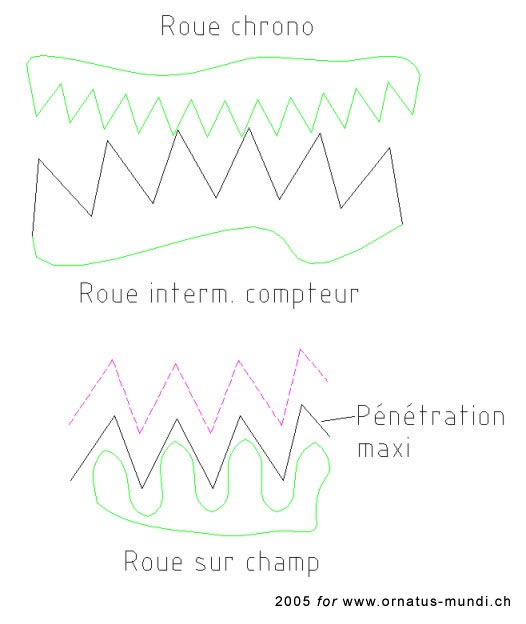
Now, after this technical excourse, let's go one floor upstairs and let us enter the watchmaker's ateliers. You will be surprised how light and friendly the look! To give you an idea on the dramatic change, here is an old atelier first, followed by the modern ones (with newly made benches, which are supported by 19th-century cast-iron bases):
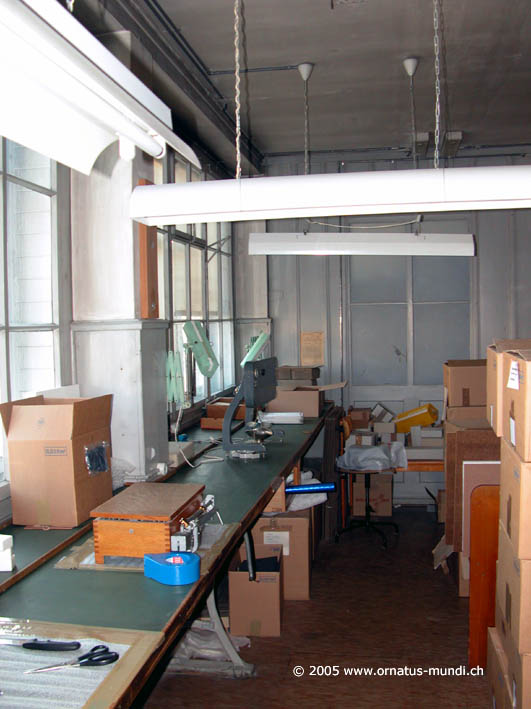
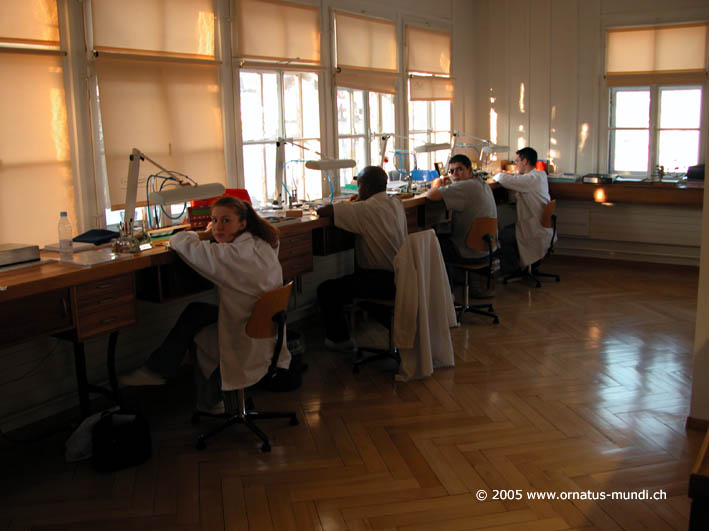
Back to our movement parts: The first station the movement plates have to pass is the jewelling bench. Manually, each jewel is set individually, albeit with an amazing speed:
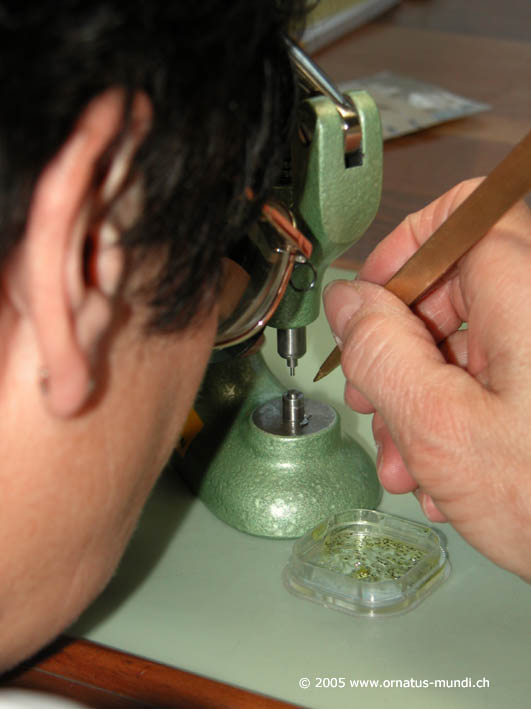
Following this, the parts are finished entirely by hand. For example, the anglage is applied using only Nickel files (large image and small image, left). A true difference to other 'hand-applied' anglage methods which employ the help of drillers! The result is not that 'perfect', but much more charming and individual (think of Phillipe Dufour!). There are two watchmakers entrusted with this painstakingly performed job (small image, middle). The result is convincing (as far as visible from the image...! Small image, right).
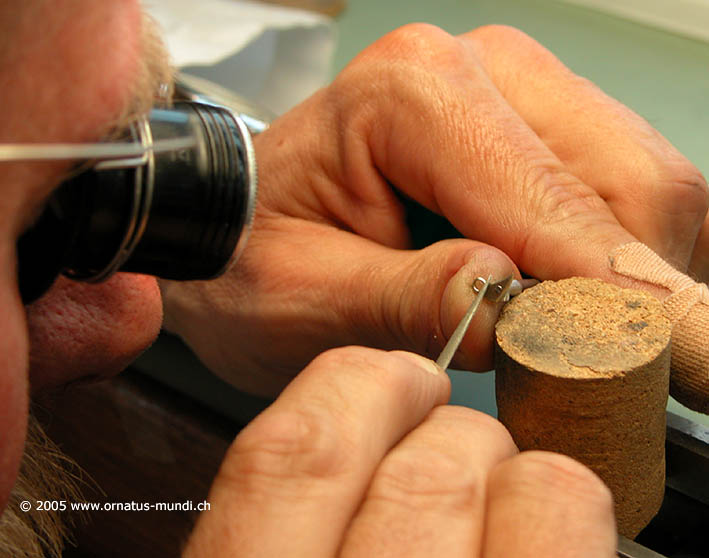
Finally, the movements are assembled by the watchmakers. The perfection Minerva wants to achieve today requires substancial skills and concentration (large image; small image, left). The watchmakers therefore do enjoy freedom on the quantities they produce each day. Demetrio Cabiddu personally checks each piece during the assembly process, and he awards it with his 'placet' only after he thoroughly inspected it (small image, middle) and after it passed the microscope and performance examinations in the 'laboratory' at the end (small image, right). Only then the Minerva movement is ready to be encased.
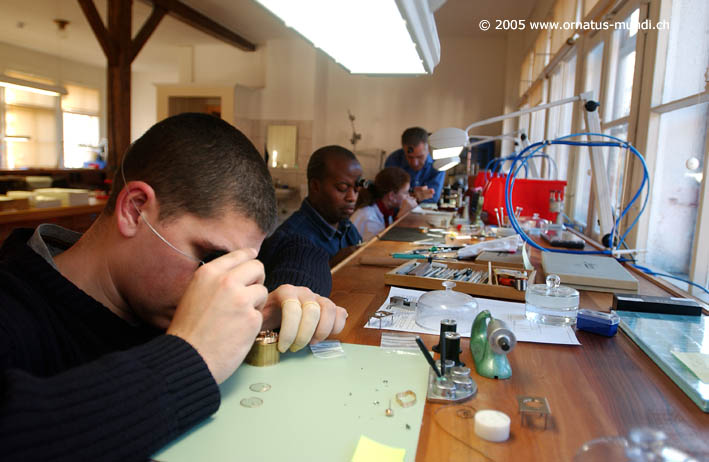
Below you can see the assembled movement (here a Cal. 62-00):
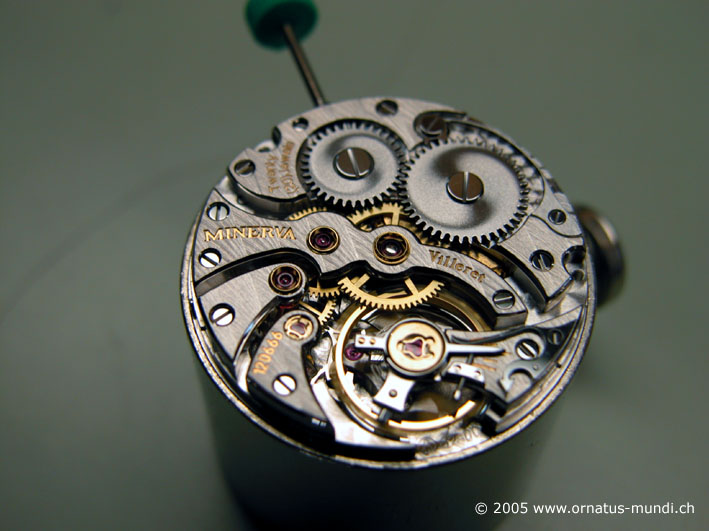
Now let's look at the final result - a beautifully finished handwound movement - the Cal. 62-00! This is what the Cal. 48 once was: the "basic" movement. Based upon the latter, this lovely little gem exhibits a mesmerising nostalgic charme, shapes of the bridges are if they were designed by Peter Paul Rubens (small image, left; look also at the the golden châtons), paired with perfect finishing (look at the unique shine of the crown- and barrel wheels (small image, middle left): the combination of côtes soleil and grinded finish gives a well-thought-off effect of fine craftmanship, while not being recognised as unique features at the first glance) and with quite some other refinements like the elaborated swan's neck microregulator (small image, middle right) or the Minerva logo executed as functional blocking-lever of the large Cal. 16-29 Monopoussoir Chronograph (small image, right).
2.3
Still something well-known and traditional: Minerva Stop watches!
I was quite
surprised to see this here in the watchmaker's ateliers: The good old
Minerva Stop watches are still being produced. The movement of course
is still the old one, and the finish as well. At the price point of
stop watches, you simply cannot provide a finish like with the rest
of the collection, says Beppe Menaldo. The movement has 7 jewels (small
image, left), and the Chronograph is of course operated by a column
wheel (small image, right).
And I can assure you, Minerva still services the old Minerva watches.
For example, when I was there, a vintage Minerva Cal. 13-20 in for an
overhaul.
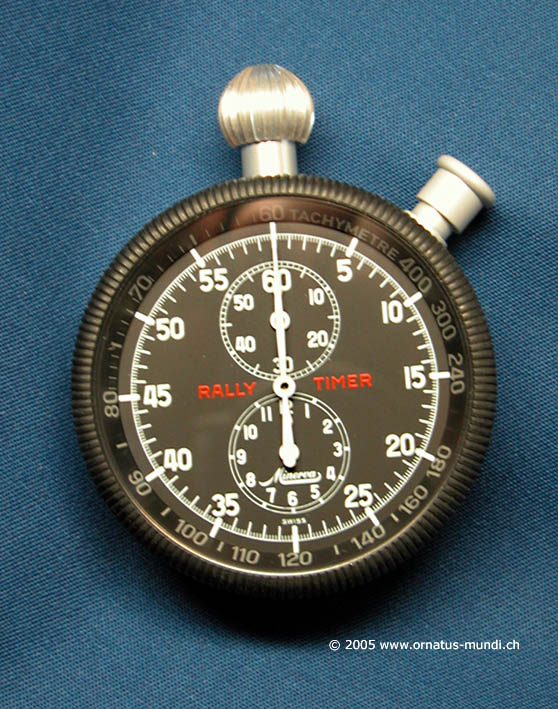
After all these informations about the savoir-faire, I guess you desperately aim to see the new collection of Minerva watches! Please follow me to the next page!
Part
1 - The Introduction
Part 2 - Watchmaking at Minerva today
Part 3 - The
current collection
Part 4 - The
Interview with Minerva's CEO, Beppe Menaldo
